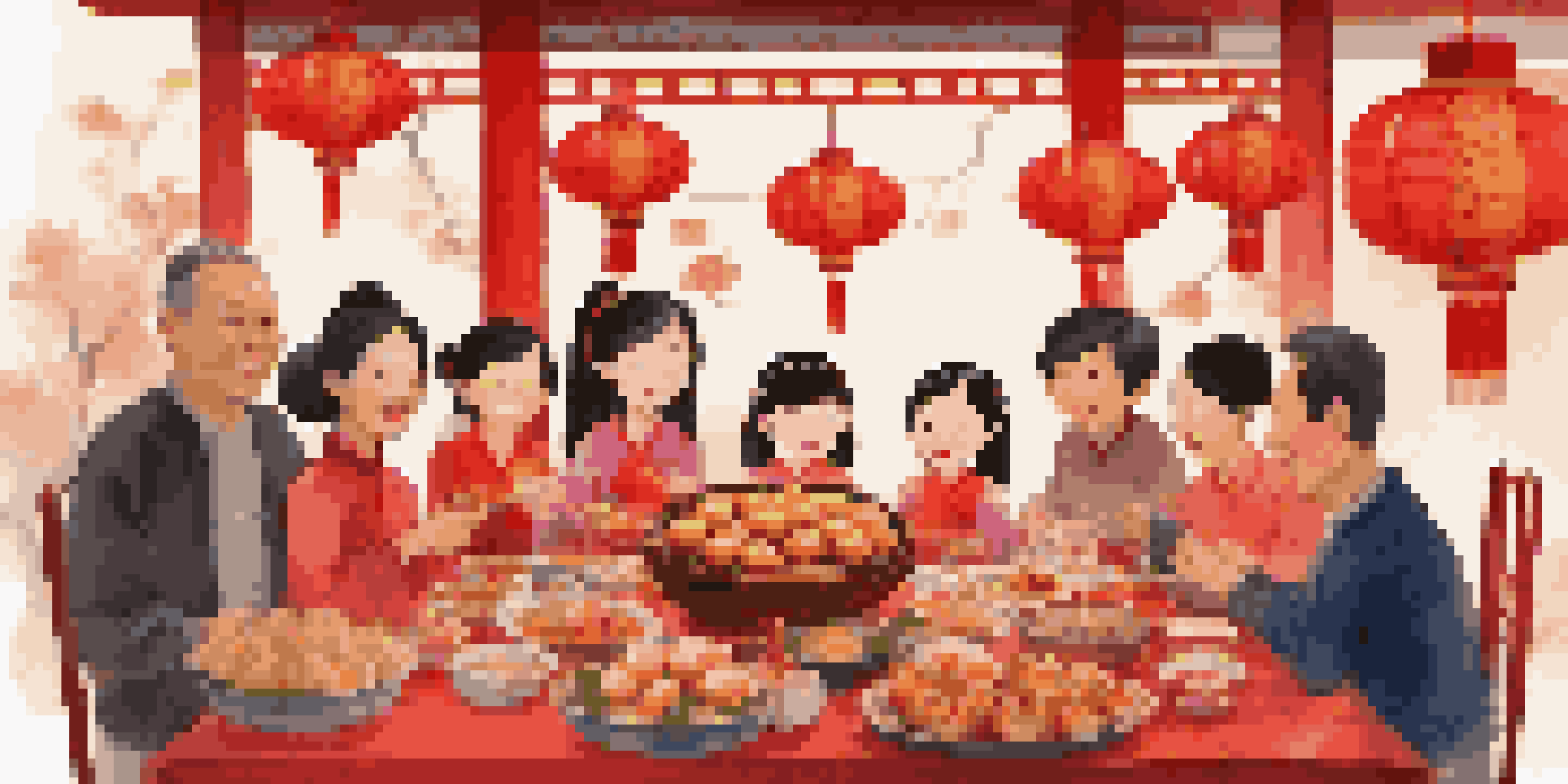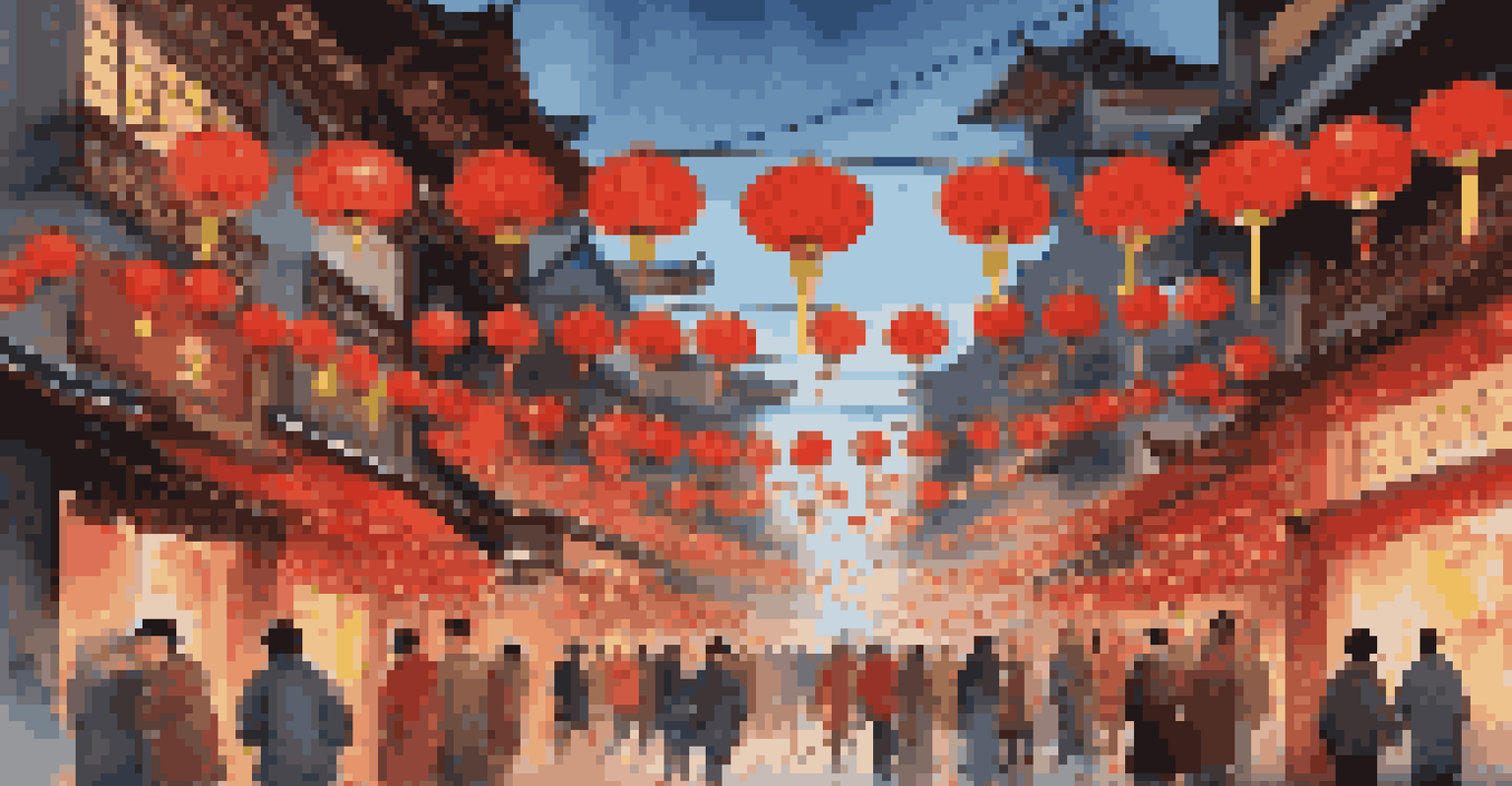The Cultural Significance of the Chinese New Year Celebrations

Understanding the Roots of Chinese New Year Celebrations
Chinese New Year, also known as the Spring Festival, has roots that date back thousands of years, intertwined with ancient agricultural practices. Traditionally, it marked the end of winter and the beginning of a new growing season. Families would gather to honor their ancestors and invite good fortune into their homes as they transitioned into a new year.
Tradition is not the worship of ashes, but the preservation of fire.
The celebration is deeply rooted in Chinese mythology, featuring tales such as the legendary monster Nian, which is said to have terrorized villages. To fend off this creature, people would light fireworks and hang red decorations, practices that continue to this day. The blend of history and myth gives the festival a rich narrative that many still cherish.
Today, while modern influences have transformed some aspects, the core values of family, renewal, and hope remain steadfast. The cultural significance of these traditions is a reminder of the importance of heritage, as families come together to celebrate their shared history.
Family Reunions: The Heart of Chinese New Year
One of the most cherished aspects of Chinese New Year is the emphasis on family reunions. During this time, millions travel long distances to be with loved ones, embodying the spirit of togetherness. It's a moment to reconnect and share stories, laughter, and traditions that have been passed down through generations.

The reunion dinner on New Year's Eve is a highlight, where families gather around a lavish feast featuring symbolic dishes like fish for abundance and dumplings for wealth. This meal is more than just food; it represents unity and the hope for prosperity in the coming year. Each dish carries meaning, making the meal a deeply symbolic affair.
Family Reunions Are Central to Traditions
Chinese New Year emphasizes family reunions, with gatherings that strengthen bonds through shared meals and storytelling.
These reunions not only strengthen family bonds but also serve as a platform for younger generations to learn about their heritage. As elders share stories and customs, they instill a sense of pride and belonging, ensuring that the cultural significance of the festival is carried forward.
Traditional Customs: Rituals that Define the Festival
Chinese New Year is adorned with vibrant customs and rituals that vary across regions, yet all share a common goal: to usher in good luck and ward off misfortune. One popular tradition includes the cleaning of homes before the New Year, symbolizing the removal of bad luck and making way for good fortune. It's akin to spring cleaning, but with a deeper cultural significance.
Family is not an important thing, it's everything.
Another engaging custom is the giving of red envelopes, or 'hongbao,' filled with money as a gesture of good wishes and blessings. This practice highlights generosity and goodwill, especially towards children and younger relatives. The color red is particularly important, as it symbolizes happiness and prosperity, making it a key element in celebrations.
These rituals create a sense of continuity and connection to the past, enriching the overall experience of the festival. They remind participants of their cultural identity and the values that accompany it, ensuring that each celebration is both a personal and communal event.
The Role of Symbols and Decorations in Festivities
Symbols and decorations play a crucial role in Chinese New Year, transforming homes and public spaces into vibrant hubs of celebration. Red lanterns, couplets, and paper cutouts adorn doorways and windows, all carrying auspicious meanings. For instance, the lanterns symbolize the hope for a bright future, while couplets express wishes for prosperity and happiness.
Families often display the character 'fu,' which means fortune, upside down on their doors. This clever placement symbolizes the arrival of good fortune, reflecting the festival's optimistic spirit. Each decoration serves as a reminder of the values and hopes associated with the New Year.
Rich Customs Enhance Cultural Identity
Vibrant customs, such as cleaning homes and giving red envelopes, are crucial for ushering in good luck and connecting participants to their heritage.
As communities come together to decorate spaces, it fosters a sense of collective joy and anticipation. These symbols create an atmosphere of festivity, inviting everyone to participate in the cultural richness of the celebration.
Culinary Delights: Food and Its Cultural Significance
Food holds a central place in Chinese New Year celebrations, with each dish carrying its own significance. For example, fish is commonly served, representing abundance, while sticky rice cakes symbolize togetherness and unity. The preparation and sharing of these dishes reinforce familial bonds and cultural traditions.
The act of preparing food together is a cherished tradition, often involving family members of all ages. It’s a time for storytelling, laughter, and bonding over recipes that may have been passed down through generations. This culinary aspect of the festival not only nourishes the body but also strengthens familial ties.
Moreover, the variety of foods consumed during the New Year reflects the diversity within Chinese culture. Different regions may have unique dishes, showcasing local ingredients and traditions, which adds richness to the celebration and fosters a sense of unity despite geographical differences.
Modern Adaptations: How the Festival Has Evolved
As society progresses, Chinese New Year celebrations have adapted to modern times, incorporating new practices while retaining traditional elements. Technology plays a significant role, as families use video calls to connect with loved ones who are far away, ensuring that distance doesn't diminish the spirit of togetherness.
Social media has also become a platform for sharing festive moments, from elaborate meals to traditional performances. This shift allows younger generations to engage with their culture in fresh ways, blending tradition with contemporary practices. It helps keep the festival alive and relevant in an ever-changing world.
Global Celebrations Embrace Unity
Chinese New Year has become a worldwide celebration, promoting cultural exchange and inclusivity through parades and community events.
Despite these modern adaptations, the essence of Chinese New Year remains intact. The core values of family, hope, and renewal continue to shine through, showcasing the festival's ability to evolve while staying true to its cultural significance.
Global Influence: Celebrating Chinese New Year Worldwide
Chinese New Year has transcended borders, becoming a global celebration embraced by diverse cultures. Cities around the world, from New York to Sydney, host vibrant parades, fireworks, and cultural performances, showcasing the festival's rich traditions. This global influence highlights the fascination and respect for Chinese culture.
In many places, local communities come together to organize events that celebrate not just the holiday, but also the values of unity and inclusivity. These festivities often feature traditional music, dance, and art, allowing people from different backgrounds to experience the beauty of Chinese culture firsthand.

The growing recognition of Chinese New Year as a significant cultural celebration fosters understanding and appreciation among diverse communities. It serves as a reminder of the power of cultural exchange and the joy that comes from celebrating together.